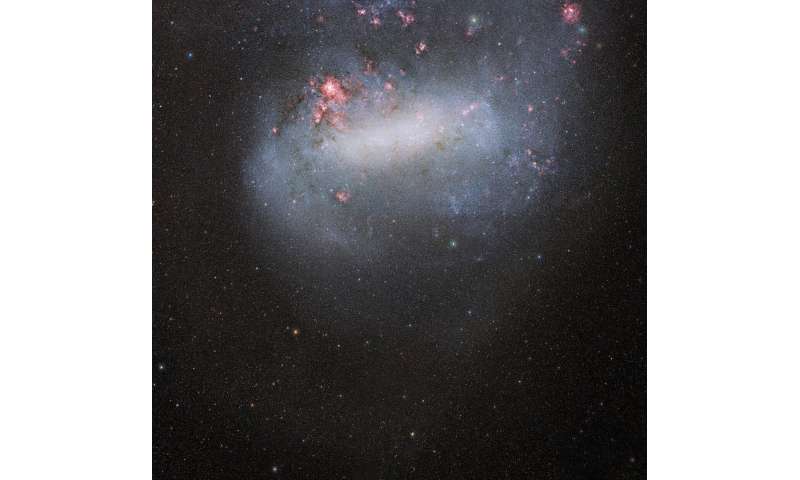Dark energy camera snaps deepest photo yet of galactic siblings

Images from the Survey of the MAgellanic Stellar History (SMASH) reveal a striking family portrait of our galactic neighbors—the Large and Small Magellanic Clouds. The images represent a portion of the second data release from the deepest, most extensive survey of the Magellanic Clouds. The observations consist of roughly 4 billion measurements of 360 million objects.
A sprawling portrait of two astronomical galactic neighbors presents a new perspective on the swirls of stars, gas, and dust making up the nearby dwarf galaxies known as the Large and Small Magellanic Clouds—a pair of dwarf satellite galaxies to our Milky Way. While this isn’t the first survey to map these nearby cosmic siblings—the Survey of the MAgellanic Stellar History (SMASH) is the most extensive survey yet.
The international team of astronomers responsible for the observations used the 520-megapixel high-performance Dark Energy Camera (DECam) on the Víctor M. Blanco 4-meter Telescope at the Cerro Tololo Inter-American Observatory (CTIO) in Chile. These data are now available to astronomers worldwide through Astro Data Lab at NOIRLab’s Community Science and Data Center (CSDC). CTIO and CSDC are both Programs of NSF’s NOIRLab.
“To date, this is the deepest and most extensive astronomical dataset of the Magellanic Clouds, which are the closest large galaxies to us,” explains David Nidever, Assistant Professor in the Physics Department at Montana State University and Principal Investigator of the SMASH survey. “These satellite galaxies have been studied for decades, but SMASH is being used to map out their structure over their full, enormous extent and help solve the mystery of their formation.”
The complete SMASH survey, which includes the view shown in these images, covers an area 2,400 times greater than the full Moon, and required about 50 nights of specialized observations. This second data release contains new data from DECam on the central and most complex regions of the Magellanic Clouds. The Large and Small Magellanic Clouds are the largest satellite galaxies of the Milky Way and, unlike the rest of the satellite galaxies, are still actively forming stars—and at a rapid pace.
Though large numbers of dwarf galaxies such as the Magellanic Clouds populate the Universe, the vast majority are too faint and distant for astronomers to study. Having the Large and Small Magellanic Clouds as neighbors provides astronomers with a unique opportunity to investigate the formation and evolution of small galaxies—but also poses a challenge.
As the Magellanic Clouds are so close to the Milky Way, they sprawl across a large area of the sky, making it challenging to map their full extent. DECam’s huge field of view allowed astronomers to capture details within some of the most interesting regions of these dwarf galaxies.
The SMASH team are using their deep dataset to study the history of star formation across both of these galaxies. They have uncovered evidence that the pair of galaxies have collided with each other in the recent past and that this sparked the recent episode of intense star formation.
“These are beautiful multicolor images of the Milky Way’s nearest neighboring galaxies. Through the care the dedicated team has taken, they give us a remarkable view of the thirteen billion year history of star formation in these galaxies,” notes National Science Foundation program officer Glen Langston.
One of the team’s long-term goals is to use the information they have obtained about the history of star formation to create a “movie” of how these galaxies evolved over time. Other topics that the SMASH team hope astronomers will explore include searching for star clusters with the help of citizen scientists and measuring the metal content of stars in the Magellanic Clouds.
“These latest SMASH data of the central regions of the Magellanic Clouds, where most of the stars are found, are unique in their combined depth, breadth, and uniformity,” Knut Olsen, NOIRLab scientist and survey co-leader explains. “Besides producing amazing images, these data allow us to look into the past and reconstruct how the Magellanic Clouds formed their stars over time; with these ‘movies’ of star formation…
Read More:Dark energy camera snaps deepest photo yet of galactic siblings
